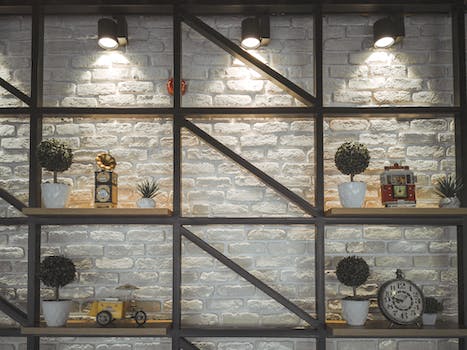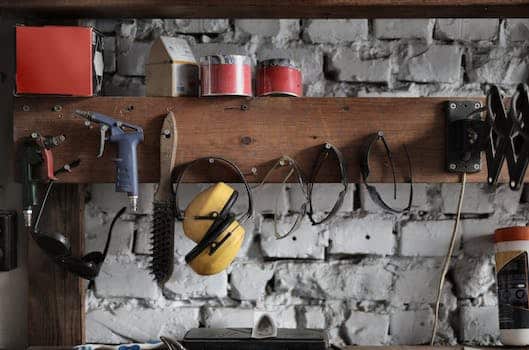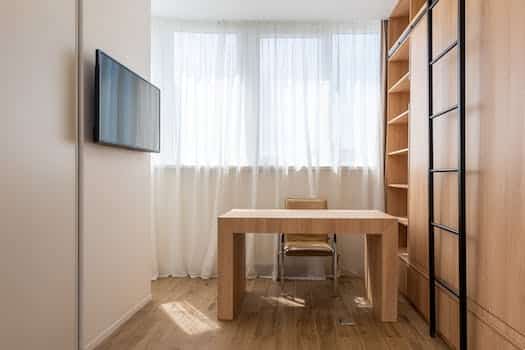Built-in shelves are the ideal solution for making the most of limited floor space. They are a great addition to any area because of the storage space they provide as well as the aesthetic and functional value they bring. Whether you want to save room on the ground or just get your stuff in order, built-in shelves are a great investment. In this piece, we’ll go through the advantages of built-in shelves and offer advice on how to make the most of them in a compact space.
- 1. Introduction
- 1.1. The need for built-in shelves in small spaces
- 1.2. Benefits of built-in shelves
- 1.3. Factors to consider when planning for built-in shelves
- 2. Designing Built-in Shelves for Small Spaces
- 2.1. Measuring the space
- 2.2. Choosing the right materials
- 2.3. Selecting the appropriate shelving style
- 2.4. Incorporating lighting into the design
- 2.5. Creating a cohesive look with the rest of the room
- 3. Installation of Built-in Shelves
1. Introduction
Are you having trouble finding places to put things because of your cramped quarters? Do you have trouble maintaining a neat and uncluttered living space? If that’s the case, then custom shelving units will work best for you. These shelves will help you make the most of your space while also enhancing the aesthetic appeal of your decor. This post will explain how to make the most of a restricted living area by installing custom shelving.
1.1. The need for built-in shelves in small spaces
The challenge of furnishing and decorating a small area is real. A room of any size can be made to feel more spacious and put together with careful planning and execution. Adding built-in bookcases to a room is a great way to make the most of the available square footage. The aesthetic value and practical use of built-in shelves cannot be overstated. Built-in shelves are a great way to make the most of a limited amount of space in a bedroom, living room, or even a bathroom. In this post, we’ll discuss why built-in shelves are so important, and how you can utilize them to make your little apartment feel more like a home.
1.2. Benefits of built-in shelves
Having shelves constructed into the wall is a common way to make the most of limited floor area. Built-in shelving allows for plenty of storage without taking up any unnecessary room on the ground. They are adaptable to any space and can be built into preexisting structures for a more natural feel. A home’s value and curb appearance can both benefit from the installation of built-in shelving. This article will discuss why built-in shelves are a good purchase for compact spaces and what advantages they offer.
1.3. Factors to consider when planning for built-in shelves
When space is at a premium, built-in shelves are a must. They serve a practical purpose as extra storage, but they also look nice. However, there are a few things to think about before you start designing for built-in shelving. The shelves will be both practical and attractive thanks to these considerations.
2. Designing Built-in Shelves for Small Spaces
It can be difficult to design built-in shelves for a tiny area, but doing so is a fantastic way to make the most of the space you have. It’s crucial to take into account the room’s proportions, the shelving’s intended usage, and the room’s aesthetic while constructing built-in shelves. Built-in shelves are convenient since they can be adjusted to fit any area, from a tight nook to a wide expanse of wall. Built-in shelves may be a terrific space-saving solution for any area, especially if they are well-designed and made of attractive materials.
2.1. Measuring the space
It’s crucial to take precise measurements of the target space before beginning to construct any built-in shelving. As a result, the shelves will be a perfect fit and won’t take up any unnecessary room. Take careful measurements of the room or space where the shelves will go, making sure to account for any impediments like walls or piping that could impact the layout. Taking precise measurements is the first step toward designing a storage solution that works for you.
2.2. Choosing the right materials
Built-in shelves for compact areas benefit from careful consideration of both the available space and the materials to be used in their construction. The weight of the products to be stored on the shelves should be one of the first considerations. Hardwood or plywood is recommended for heavier goods such as books or ornamental objects. Particleboard and MDF are suitable for smaller items like decorative accents and houseplants.
The aesthetic quality of the area should also be thought about. Hardwood or natural wood veneers can be used to create a cozy ambiance in a space with a classic or traditional design scheme. Laminates and high-gloss finishes are great for creating a contemporary or modern atmosphere.
Finally, think about how long the materials will last and how much upkeep they’ll require. Hardwood and natural wood veneers last a long time and can be refinished if they get scratched or worn down. Easy to clean and maintain, laminates and high-gloss surfaces can chip or peel if not properly cared for. By keeping these things in mind, you can make built-in shelves that are both elegant and practical for any tiny room.
2.3. Selecting the appropriate shelving style
Choosing the right shelving style is essential when planning built-in shelves for compact rooms. With the correct shelving design, you can make the most of your storage space. The room’s dimensions, the goods to be housed, and the desired aesthetic all play a role in determining the best shelf option. Floating shelves, ladder shelves, and corner shelves are all great choices for maximizing limited floor space. There are pros and cons to every possible shelving configuration, so it’s crucial to weigh your options thoroughly before making a purchase.
2.4. Incorporating lighting into the design
Lighting plays a crucial part in the design of built-in bookcases, especially when working with limited space. Lighting the shelves not only improves their practicality, but also serves as an aesthetic touch. A soft glow can be achieved by installing LED strip lights along the shelf’s perimeter. Alternatively, you might install recessed illumination onto the shelves themselves. This can be used to draw attention to specific items on the shelf. Whether you go for wall sconces or under-shelf lighting, you’ll be able to turn even the tiniest room into a warm and welcoming setting.
2.5. Creating a cohesive look with the rest of the room
It is essential to achieve visual harmony when constructing built-in shelves for compact areas. This involves thinking about the space’s entire aesthetic, including its color scheme, style, and design. Choose floating shelves that are as simple as possible so they don’t detract from the room’s modern, minimalist aesthetic. However, if you’re going for a more classic or eclectic look, ornate brackets or molding might be a great way to spice up your shelving. Built-in shelves may be both practical and aesthetically pleasing additions to a room if you put some thought into their layout.
3. Installation of Built-in Shelves
Putting in built-in shelves is a great way to make the most of limited floor area. These shelves are tailored to the exact measurements of the room, allowing you to make use of previously unused corners. The adjustable shelves are perfect for displaying and storing books, trinkets, and other treasures. In addition, built-in shelves can be customized to complement the existing decor for a more unified and refined overall effect. In conclusion, built-in shelves are a chic and practical solution for optimizing limited floor space.
3.1. Preparing the space for installation
It is necessary to get the area ready for built-in shelves before installing them. To begin, clear the area where the shelves will go of any existing fixtures or storage containers. This will help you visualize the room and determine the best placement for the shelves.
The next step is to take precise measurements and outline the area where the shelves will go. This will give you a better idea of how many and what size shelves to buy. The distance between shelves and their height should also be taken into account.
After the space has been organized, shelving can be set up. Always use the correct tools and hardware, as specified by the manufacturer. If the shelves will be holding heavy objects, further care must be taken to ensure they are securely fastened to the wall.
Spend some time when the installation is finished arranging the shelves. To maintain order, make use of baskets, boxes, and other containers. With some forethought and preparation, built-in shelves may be an excellent space-saving and organization tool.
3.2. Tools needed for installation
It’s crucial to make sure you have everything you need to build built-in shelves before you get started. A few examples of these items are a ruler, a level, a drill, some screws, and some brackets. A stud finder will come in handy for making sure the shelves are properly fastened to the wall studs. In addition, a drop cloth or tarp might be useful for protecting the floor from any potential mess if the shelves are being built in a living space.
3.3. Step-by-step installation process
The headline of a blog post is one of its most crucial parts. They are the first thing that people see when they come across your post, and they often determine whether or not they will continue reading. Even if 80% of visitors read your title, just 20% will go on to read the whole of your piece, according to research. Since you just have a few seconds to attract a reader’s attention, it’s crucial that your headlines are catchy, interesting, and search engine friendly.
3.4. Adding finishing touches to the shelves
After the shelves have been constructed, the final touches must be applied so that they have a finished, polished aspect. Depending on the style of the space, this may involve painting or staining the shelves, adding trim to the edges, and fixing any nail holes or gaps with wood filler. Putting forth the effort to add these details would greatly improve the look of the shelves.
The next step, after the shelves have been built, is to set them up in the space. The best way of mounting shelves on a wall can change based on a number of factors. If you want to make sure your installation goes smoothly, you should either follow the manufacturer’s guidelines or get some expert help. Now that the shelves are in place, you can begin sorting and arranging your belongings to make the most efficient use of the available area.
3.5. Maintenance of built-in shelves
If you want your built-in shelves to serve you well for many years after they have been placed, you must take good care of them. Here are some suggestions for taking care of your custom cabinetry:
First, keep the shelves clean and free of dust and debris by cleaning them on a regular basis.
If you don’t want your shelves to sag or shatter, don’t load them down with heavy or oversized things.
Third, keep an eye out for signs of damage or wear and tear on the racks, and promptly repair any worn or broken components.
Following these guidelines can help your built-in shelves last for many years with minimal effort on your part.
Conclusion
In conclusion, if you’re short on square footage, built-in shelves are a great investment. You can make your home more practical and well-organized without sacrificing its aesthetic value by taking advantage of vertical space and integrating storage solutions into the design.






These 10 innovative and imaginative DIY home decor ideas from [object Object] provide a refreshing approach to enhancing ones living…